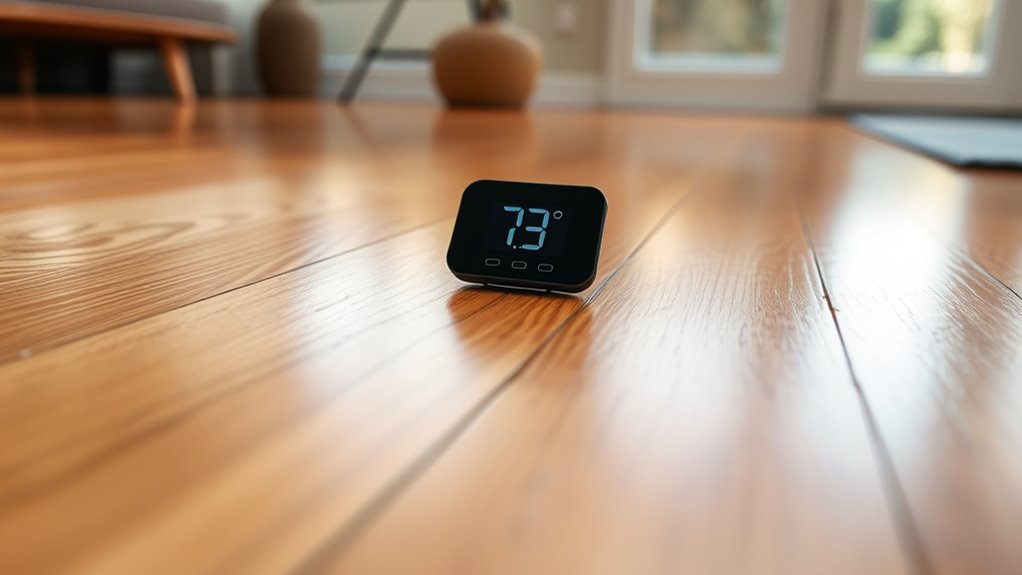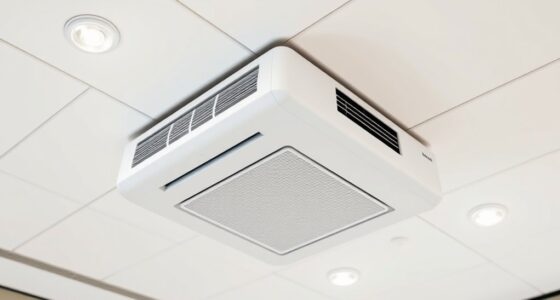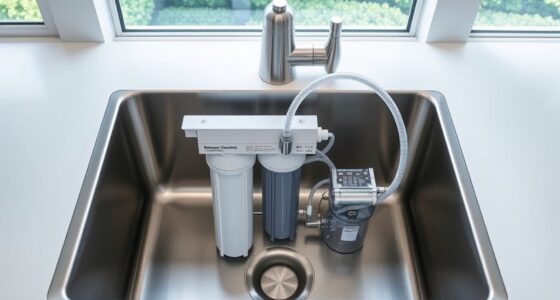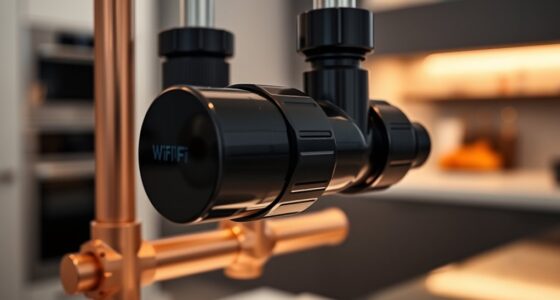If you’re looking for the best radiant heat thermostat floor sensors for precise temperature control, I’ve found that top options include sensors with high accuracy, durable insulation, and compatibility with various systems like Honeywell and smart thermostats. Many feature flexible wiring, waterproof ratings, and safety certifications for reliable use. Whether you want manual, programmable, or smart control, there’s a sensor designed for it. Keep exploring to discover the perfect fit for your underfloor heating needs.
Key Takeaways
- Features high-accuracy 10k ohm thermistors for precise temperature sensing within ±0.5°F.
- Constructed with durable, moisture-resistant and impact-proof materials for long-term reliability.
- Compatible with most radiant heating systems and easy to install with flexible, low-profile cables.
- Certified safety with UL, CSA, and waterproof ratings, supporting safe operation in various environments.
- Many models offer smart connectivity via Wi-Fi or Bluetooth for remote control and energy management.
Temperature Floor Sensor for Radiant Under Floor Heating

If you’re looking for a reliable temperature floor sensor for radiant underfloor heating, the LuxHeat Universal Floor Sensor is an excellent choice. I appreciate its accuracy and compatibility with many systems like Honeywell, NuHeat, and SunTouch. The sensor features a 10k ohm thermistor, ensuring precise temperature readings, and comes with a flexible 15-foot cable for easy installation. Its simple connection to thermostats makes setup straightforward. I also value its durability, with PVC insulation protecting it during use. Overall, this sensor helps maintain safe, comfortable, and energy-efficient heating, making it a dependable choice for your radiant flooring system.
Best For: homeowners and installers seeking a reliable, accurate floor temperature sensor compatible with various radiant underfloor heating systems for safe and efficient temperature regulation.
Pros:
- Highly accurate with a 10k ohm thermistor for precise temperature readings
- Compatible with multiple thermostat brands like Honeywell, NuHeat, and SunTouch
- Long 15-foot flexible cable allows easy installation and adjustments
Cons:
- Requires proper installation between heating cables to ensure accuracy
- Must be connected correctly to thermostat terminals, which may require some technical knowledge
- As an indoor sensor, it’s not suitable for outdoor or exposed environments
Insulated Floor Heating Thermostatic Sensor Wire
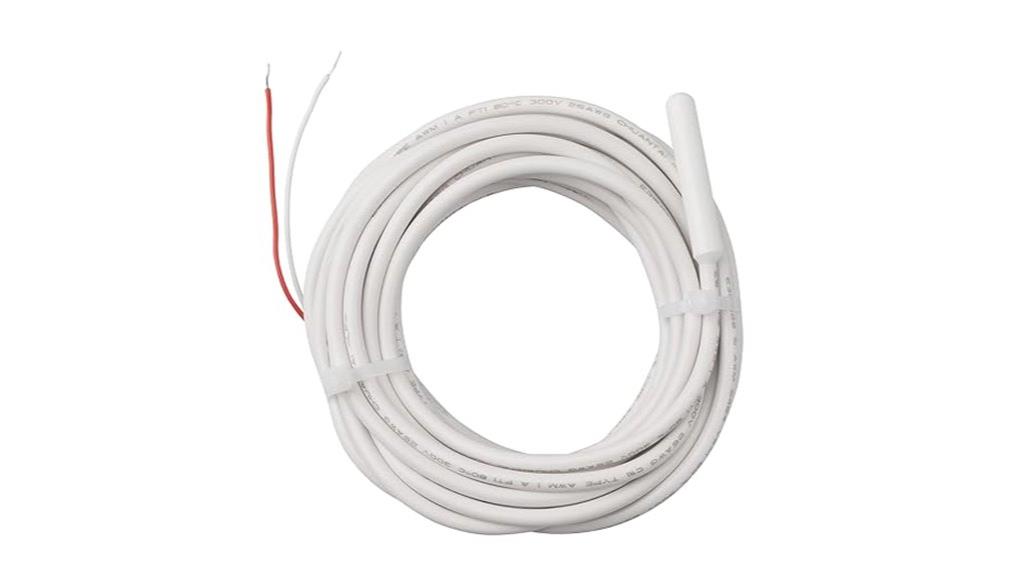
The Insulated Floor Heating Thermostatic Sensor Wire is an ideal choice for homeowners and professionals seeking precise and reliable temperature control in electric radiant floor systems. Its 10KΩ sensor provides accurate floor temperature readings with ±1°F precision, guaranteeing maximum comfort. The ultra-slim housing (0.3 inches) allows seamless embedding within floor mortar or compounds, keeping the installation clean and unobtrusive. Featuring SmartStart adaptive technology, it detects thermal shifts up to five times faster than standard sensors, enabling quick system adjustments. Certified as a plug-and-play OEM replacement for SunStat thermostats, it simplifies upgrades and guarantees compatibility with various electric heating setups.
Best For: homeowners and professionals seeking precise, reliable, and easy-to-install temperature control for electric radiant floor heating systems.
Pros:
- Provides highly accurate floor temperature measurement with ±1°F precision.
- Ultra-slim design (0.3 inches) allows seamless, invisible installation under finished floors.
- SmartStart technology detects thermal shifts up to five times faster, ensuring quick system response.
Cons:
- Requires verification that the thermostat has a dedicated floor sensor input terminal for proper operation.
- Compatible only with systems that support 120V/240V electric radiant heating and plug-and-play sensors.
- Installation may be limited to professionals or experienced DIYers familiar with floor heating systems.
Programmable Thermostat for Underfloor Heating with GFCI (120/240V)
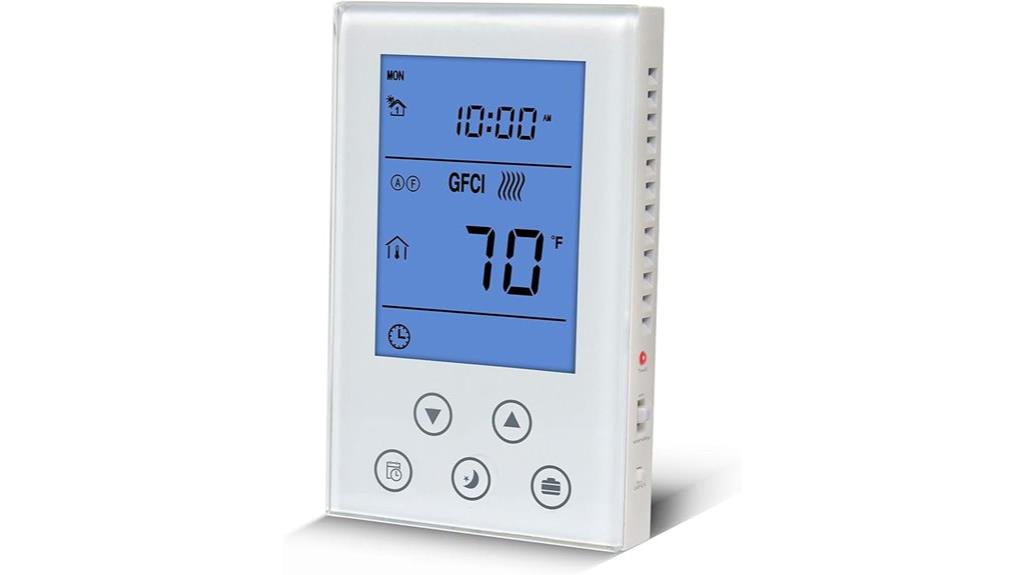
A programmable thermostat with GFCI protection is essential for anyone seeking safe and reliable control over their underfloor heating system. I appreciate its compatibility with both 120V and 240V systems, making it versatile for various homes. The built-in GFCI (5mA) adds an extra layer of safety by preventing electric shocks and electrical fires, alerting me if leakage occurs. Its 7-day programmable schedule helps optimize comfort and energy efficiency, while the large backlit LCD makes adjustments easy. Made of durable, fire-resistant material, it’s designed for easy wall mounting. Overall, this thermostat combines safety, flexibility, and convenience for precise radiant floor heating control.
Best For: homeowners seeking a safe, reliable, and energy-efficient control solution for their underfloor heating systems that can operate with both 120V and 240V power supplies.
Pros:
- Equipped with built-in GFCI (5mA) for enhanced safety against electric shocks and leaks
- Compatible with various radiant floor heating systems and features a user-friendly 7-day programmable schedule
- Durable, fire-resistant design with easy wall-mount installation and a clear, backlit LCD display
Cons:
- Limited to a maximum load of 15A, which may not suit larger or high-power heating setups
- Requires wired installation and proper setup, potentially needing professional assistance
- May have a higher upfront cost compared to simpler, non-programmable thermostats
AC11201 Floor Temperature Sensor for Honeywell Heating Systems
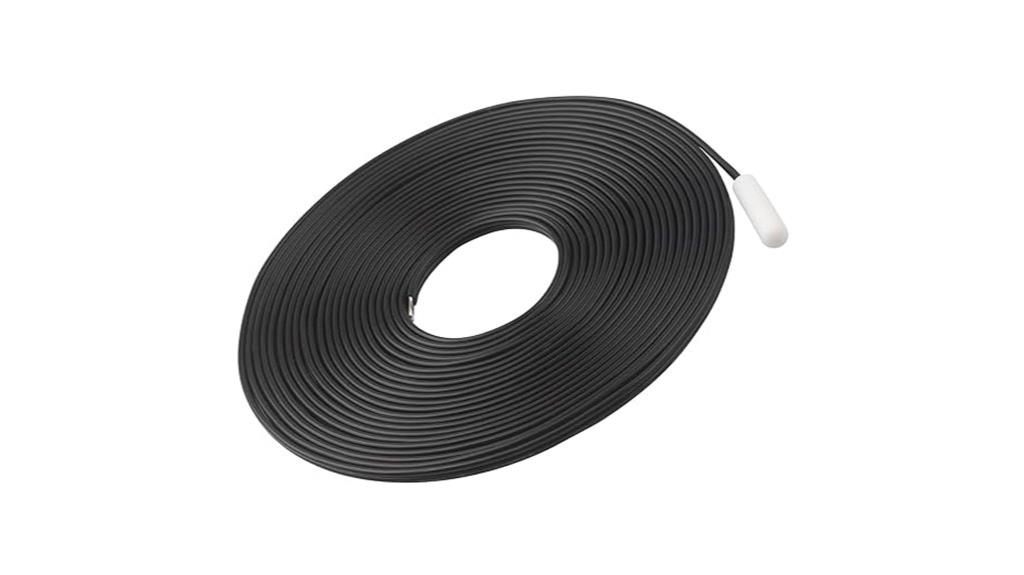
For those seeking a reliable and precise solution for radiant floor heating, the AC11201 Floor Temperature Sensor stands out as an ideal choice. It’s a complete, plug-in replacement compatible with various Honeywell heating models and systems. Designed for durability, it features overmolded construction that protects against moisture and physical damage, ensuring long-term reliability. The sensor provides accurate temperature readings within ±0.5°C, helping maintain consistent comfort. Installation is straightforward—just swap out the old sensor with no special tools needed. Whether used with radiant heat wire or underfloor systems, this sensor guarantees seamless integration and dependable performance.
Best For: homeowners and contractors seeking a reliable, precise, and easy-to-install sensor for radiant floor heating systems using Honeywell thermostats.
Pros:
- Provides accurate temperature readings within ±0.5°C for optimal performance
- Durable overmolded design protects against moisture and physical damage
- Compatible with a wide range of Honeywell models and digital thermostats
Cons:
- Installation requires power off and gloves, which might be inconvenient for some users
- Limited to systems compatible with Honeywell models listed, not universal for all brands
- Replacement may necessitate professional assistance for optimal setup in complex installations
Honeywell Programmable Radiant Heating Thermostat
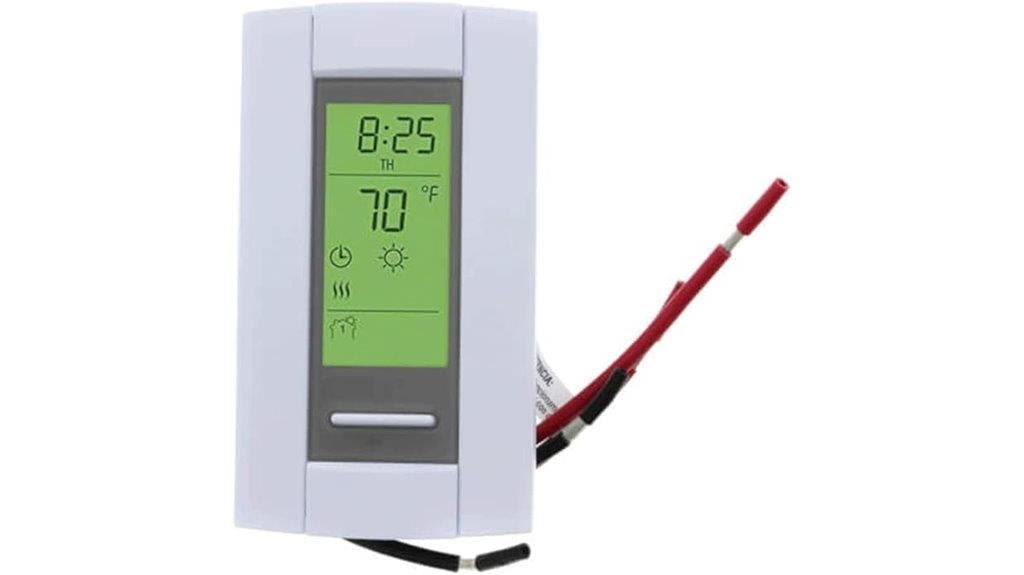
If you’re seeking a versatile thermostat that offers precise control over radiant floor heating, the Honeywell TH115-AF-GA/U stands out as a top choice. This digital, wall-mounted device features 7-day programming, supporting both 120V and 240V systems, with a 3600W capacity. It allows you to set ambient, floor, or combined temperatures, ensuring tailored comfort. The thermostat includes a floor sensor and GFCI for safety, plus Wi-Fi connectivity for remote management via an app. Its modern design boasts a backlit LCD screen and easy button controls. Overall, it’s user-friendly, reliable, and suitable for residential or commercial radiant heating systems.
Best For: homeowners and professionals seeking precise, programmable control of radiant floor heating systems with remote accessibility.
Pros:
- Supports 7-day programming for tailored comfort schedules
- Wi-Fi connectivity allows remote control via mobile app
- Includes a floor sensor and GFCI for enhanced safety and safety compliance
Cons:
- Installation may require technical knowledge or professional assistance
- Limited to radiant floor heating systems; not suitable for other heating types
- Physical buttons and display may be less intuitive for some users compared to touchscreen interfaces
Honeywell AC11201 Temperature Sensor for Floor Heating Applications

The Honeywell AC11201 Temperature Sensor stands out as an excellent choice for professionals and homeowners seeking reliable temperature sensing in radiant floor heating systems. Designed for both flexible and rigid sensors, it guarantees accurate readings across various installation setups. The 10-foot cable simplifies wiring and positioning, making installation straightforward. Manufactured in the United States, it meets strict quality standards and North American regulations. As a dedicated floor heating sensor, the AC11201 provides precise temperature control, helping to optimize comfort and energy efficiency. Its durability and compatibility make it a dependable option for maintaining consistent warmth in any radiant floor heating system.
Best For: homeowners and professionals seeking reliable and accurate temperature sensing for radiant floor heating systems in North American installations.
Pros:
- Provides precise temperature readings for optimal system performance
- Includes a 10 ft cable for flexible installation options
- Manufactured in the United States, ensuring high quality and compliance
Cons:
- Designed specifically for floor heating, may not suit other temperature sensing needs
- Rigid and flexible sensor options may require different handling or installation techniques
- Limited to North American standards, potentially less compatible with international systems
Honeywell TH6100AF2004 T6 Pro-1 Heat Slab Sensor Thermostat
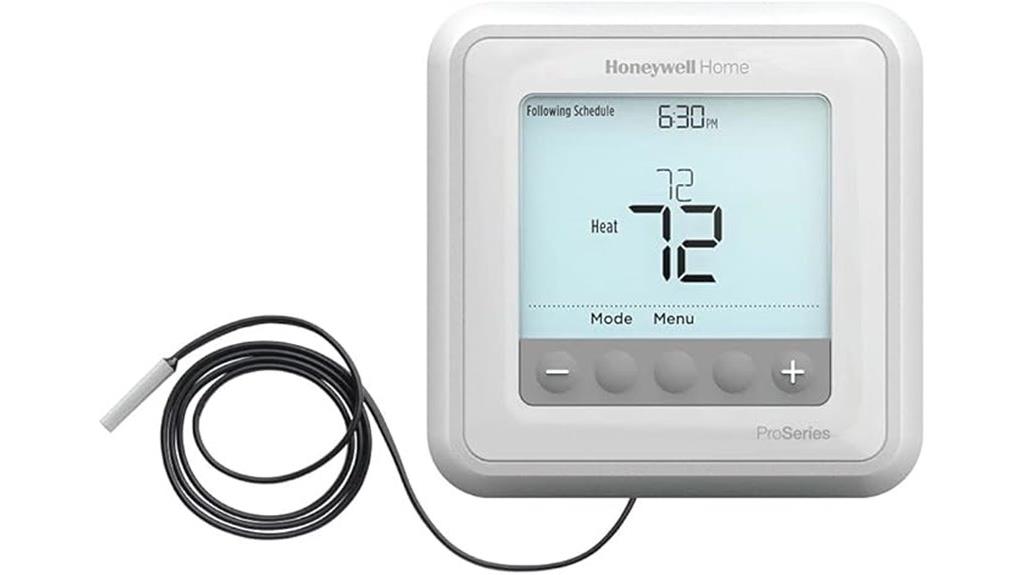
The Honeywell TH6100AF2004 T6 Pro-1 Heat Slab Sensor Thermostat is ideal for homeowners with boiler systems who want reliable temperature control without the fuss of smart features. Made in the US, it measures about 6.2 x 5.1 x 2.5 inches and weighs 13 ounces. It offers 1-stage heat-only operation with flexible control of ambient air, floor temperature, or both, including safety limits to prevent damage. Its features include antifreeze protection, boiler short cycling prevention, programmable schedules, Vacation Hold, and Economy Mode. While it supports app control and wired protocols, it doesn’t support Wi-Fi, and some users report setup challenges and sensor issues.
Best For: homeowners with boiler systems seeking a reliable, straightforward thermostat without smart features or Wi-Fi connectivity.
Pros:
- Reliable and well-made build quality praised by users.
- Offers flexible climate control options for ambient air and floor temperature.
- Features programmable schedules, antifreeze protection, and safety limits for floor damage prevention.
Cons:
- Does not support Wi-Fi or app control despite misleading product listings.
- Installation and setup can be complex, especially for non-professionals.
- Reports of faulty in-floor sensors and lack of support for sensor replacement or troubleshooting.
UTN4 Radiant Floor Heat Thermostat with GFCI
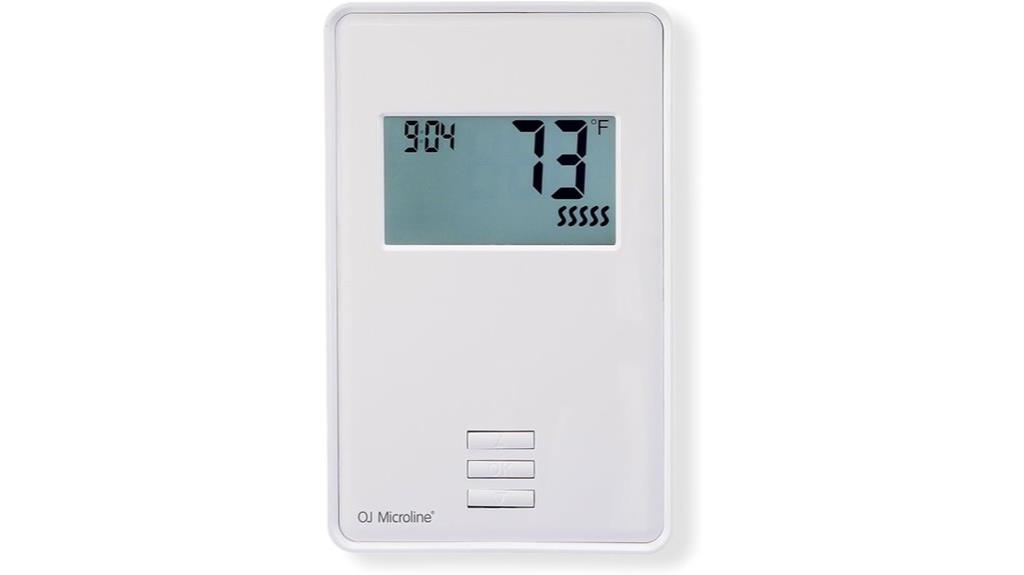
Designed for DIY enthusiasts and homeowners seeking reliable underfloor heating control, the UTN4 Radiant Floor Heat Thermostat with GFCI combines ease of use with essential safety features. It’s compatible with 120/240V circuits and works with various flooring types, including tile, carpet, and laminate. The sleek digital display is backlit and flush-mounted, making installation straightforward. It supports Bluetooth and Wi-Fi for remote control and includes a built-in Class A GFCI for safety. With dual sensors and multiple control modes, it ensures precise temperature regulation while safeguarding your floor. Its simple, non-programmable design makes it perfect for quick setup and reliable performance.
Best For: DIY homeowners and enthusiasts seeking an easy-to-install, reliable underfloor heating thermostat with safety features and remote control capabilities.
Pros:
- Simple, non-programmable setup ideal for quick installation and use
- Built-in Class A GFCI enhances safety for all floor types
- Supports Bluetooth and Wi-Fi for convenient remote adjustments
Cons:
- Limited to basic temperature control without advanced programming options
- Installation may require planning for existing electrical boxes, especially metal outlets
- Only supports up to 1800W, which might be insufficient for larger or high-wattage systems
SunTouch SunStat ConnectPlus Wi-Fi Thermostat with Touchscreen and Voice Control
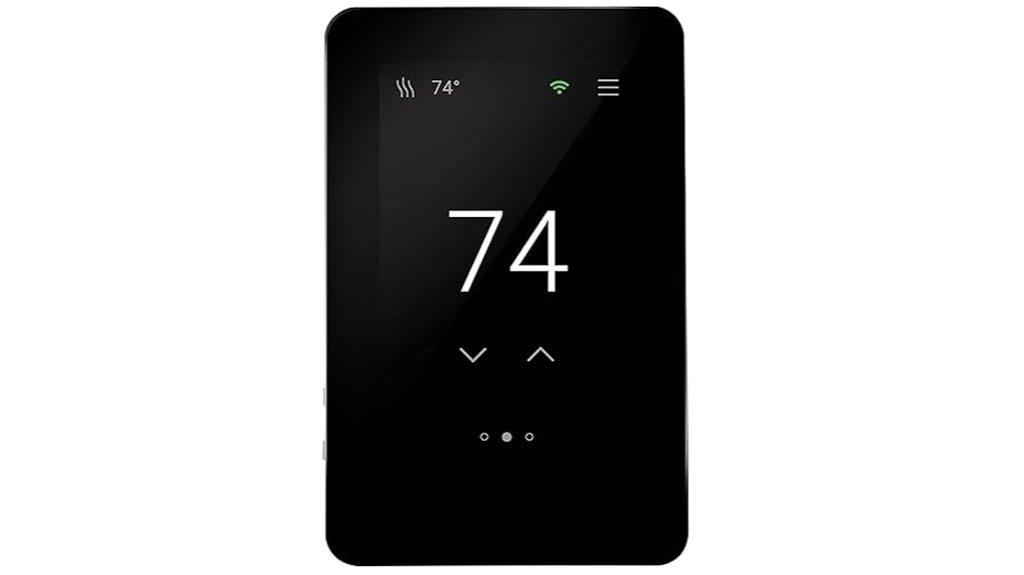
If you’re looking for a smart thermostat that seamlessly integrates with modern home automation, the SunTouch SunStat ConnectPlus Wi-Fi Thermostat is an excellent choice. Its sleek, touchscreen design features a large 4.3-inch display, making it easy to read and operate. With Wi-Fi connectivity, you can control and schedule your radiant floor heating remotely via the Watts Home app on iOS or Android. It supports voice commands through Alexa and Google Assistant, and offers advanced features like weather display, energy monitoring, and diagnostic tools. The thermostat’s SmartStart technology ensures warm floors at scheduled times, providing both convenience and precise temperature regulation.
Best For: homeowners and professionals seeking a modern, Wi-Fi-enabled thermostat for precise control of electric radiant floor heating systems with smart home integration.
Pros:
- Sleek, intuitive touchscreen interface with large display for easy operation
- Seamless Wi-Fi connectivity allows remote control via the Watts Home app on iOS and Android
- Supports voice commands through Alexa and Google Assistant, enhancing smart home integration
Cons:
- May require professional installation for optimal setup and configuration
- Limited to electric floor heating systems, not compatible with other heating types
- Advanced features and app setup might have a learning curve for some users
WiFi Programmable Thermostat for Radiant Floor Heating
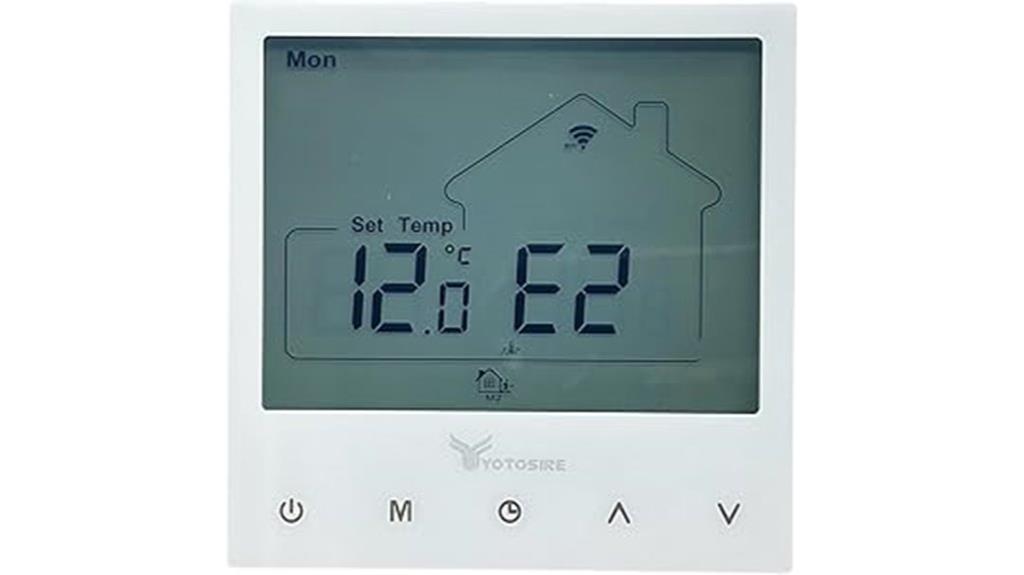
A WiFi programmable thermostat with app control and voice compatibility is an excellent choice for homeowners seeking convenient, precise control over their radiant floor heating. It features a sleek touchscreen, allowing easy adjustments, and supports iOS and Android app control for remote management. Voice commands with Alexa and Google Home make it even more accessible. Equipped with floor and air sensors, it maintains ideal comfort while saving energy. Made from flame-retardant materials and protected by anti-surge circuitry, it prioritizes safety and durability. With customizable 7-day schedules and 0.5°C accuracy, this thermostat ensures your heating is tailored exactly to your needs.
Best For: homeowners seeking a convenient, energy-efficient, and precise control solution for radiant floor heating with smart home integration.
Pros:
- Easy remote control via app on iOS and Android devices for added convenience.
- Supports voice commands with Alexa and Google Home, enabling hands-free operation.
- Equipped with floor and air sensors for accurate temperature regulation and energy savings.
Cons:
- Installation may require some technical knowledge due to Wi-Fi and app setup processes.
- Limited to heating control specifically for radiant floor systems; not suitable for other HVAC types.
- First available date listed as June 10, 2025, which may be a future release or typo, potentially affecting immediate purchase plans.
Touchscreen Programmable Radiant Floor Heating Thermostat

The Touchscreen Programmable Radiant Floor Heating Thermostat (Model UDG4-4999) is an excellent choice for homeowners and professionals seeking precise, customizable control over radiant heating systems. Its 3.5-inch color LCD provides an intuitive interface for easy programming and adjustments. Supporting dual voltage (120V/240V) and compatible with various heating setups, it offers flexible installation options. Features like 7-day scheduling, floor and air sensing, safety protections, and detailed energy logging make it highly versatile. Its sleek design, backlit display, and robust safety standards ensure reliable operation in residential or commercial settings. Overall, it combines modern technology with user-friendly functionality for ideal radiant heat management.
Best For: homeowners and professionals seeking precise, customizable control over radiant floor heating systems with user-friendly programming and safety features.
Pros:
- Easy-to-use 3.5-inch color LCD touchscreen interface for quick adjustments
- Supports dual voltage (120V/240V) and various heating system compatibilities
- Includes safety features like GFCI, child lock, and floor protection settings
Cons:
- May require professional installation due to wiring complexity
- Limited to radiant floor heating systems, not suitable for other HVAC types
- Slightly higher price point compared to basic thermostats
UDG4 Touchscreen Programmable Floor Thermostat with GFCI

When selecting a thermostat for electric radiant floor heating, the UDG4 Touchscreen Programmable Floor Thermostat with GFCI stands out for its advanced safety features and user-friendly interface. It supports dual voltage (120V/240V) and various flooring types, including tile, marble, and wood. The 3.5-inch color touchscreen offers easy programming with a 7-day schedule and adaptive learning to optimize comfort and energy use. Safety is enhanced by its GFCI ground fault protection and floor limiting features. Compact and stylish, it’s backed by a 3-year warranty and USA support, making it a reliable choice for precise temperature control.
Best For: homeowners and professionals seeking a safe, versatile, and easy-to-program thermostat for electric radiant floor heating systems across various flooring types.
Pros:
- Supports dual voltage (120V/240V) and multiple flooring materials for broad compatibility.
- Features a user-friendly 3.5-inch touchscreen with customizable schedules and adaptive learning.
- Includes GFCI ground fault protection and floor limiting safety features for enhanced safety.
Cons:
- May be more expensive than basic thermostats due to advanced features.
- Requires professional installation for optimal setup and wiring.
- Limited to electric radiant floor heating systems; not compatible with other heating types.
Electric Radiant Floor Heating Thermostat with WiFi, Touch Screen & Floor Sensor
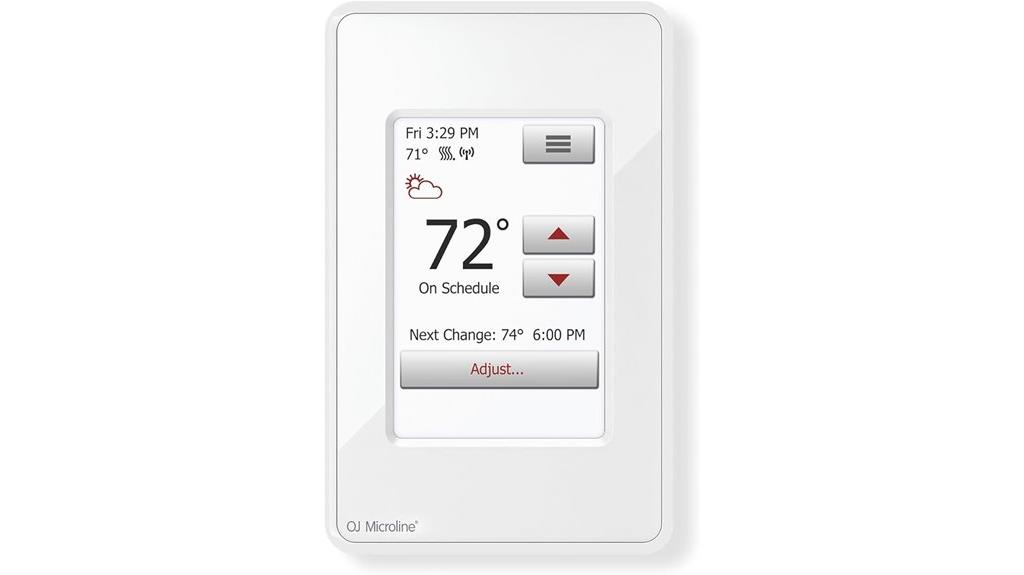
If you’re looking for a smart, user-friendly thermostat to enhance your electric radiant floor heating system, the UWG4-4999 model from OJ Microline stands out. It offers WiFi connectivity, a sleek touchscreen interface, and a floor sensor for precise temperature control. Compatible with most floor types, including tile, marble, and wood, it supports dual voltage and features GFCI protection for safety. The thermostat allows 7-day programmable schedules, remote control via smartphone, energy monitoring, and adaptive self-learning to save energy. Its modern design, child lock, vacation mode, and easy installation make it a versatile, efficient choice for maintaining ideal comfort.
Best For: homeowners seeking a smart, easy-to-install thermostat with precise temperature control for their electric radiant floor heating systems.
Pros:
- WiFi connectivity allows remote control and monitoring via smartphones or tablets.
- User-friendly 3.5-inch touchscreen with programmable 7-day schedules and adaptive energy-saving features.
- Compatible with multiple floor types and supports dual voltage for versatile installation.
Cons:
- Requires WiFi connection for full remote features, which may be limiting without internet access.
- Installation may need basic electrical knowledge; professional help might be necessary for some setups.
- Limited to 15 amps, so may not be suitable for systems exceeding 1800W at 120V or 3600W at 240V.
Floor Heat Sensor Probe 10Kohm
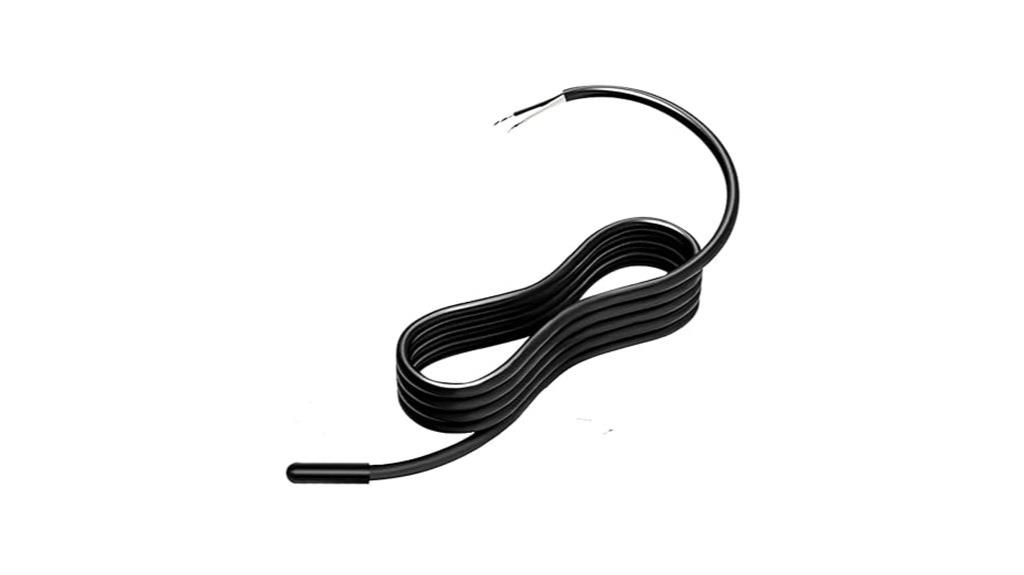
For anyone seeking precise temperature control in their underfloor heating system, the Floor Heat Sensor Probe 10Kohm offers reliable performance with its stable resistance value and quick response time. Its 10Kohm resistance guarantees accurate temperature sensing, while the 119-inch wire provides flexibility during installation. Built with high-quality insulation sealing, it resists mechanical impacts, bending, and environmental stress, ensuring long-term durability. Compatible with most radiant heating systems and thermostats, it simplifies setup and integration. Customers appreciate its ease of installation and consistent performance, making it a dependable choice for maintaining optimal floor temperatures and preventing overheating over time.
Best For: homeowners and installers seeking precise, reliable temperature control for underfloor heating systems to ensure efficiency and safety.
Pros:
- Accurate 10Kohm resistance for precise temperature sensing
- Long 119-inch wire provides flexible installation options
- Durable insulation sealing resists mechanical impacts and environmental stress
Cons:
- May require additional components like extra wire or compatible thermostats for full setup
- Installation might be challenging for those unfamiliar with electrical components
- Limited to compatible underfloor heating systems, not suitable for all heating configurations
Factors to Consider When Choosing a Radiant Heat Thermostat Floor Sensor

When choosing a radiant heat thermostat floor sensor, I consider how well it matches my system’s compatibility and the sensor’s accuracy and range. I also look for easy installation, durable materials, and safety certifications to guarantee long-term performance. Understanding these factors helps me select the best sensor for reliable, safe operation.
Compatibility With System
Choosing a compatible radiant heat thermostat floor sensor is crucial for guaranteeing your system functions correctly and efficiently. First, double-check that the sensor matches your specific system’s model and brand to avoid compatibility issues. Verify the sensor’s resistance value, typically 10K ohms at 77°F (25°C), aligns with your thermostat’s requirements for precise readings. Also, confirm the wiring type and connector fit your system’s terminals to ensure a seamless setup. It’s important to select a sensor designed for indoor use and suitable for your flooring material, preventing damage and measurement errors. Lastly, consider the sensor’s length and flexibility, making sure it fits easily within your installation environment and can be positioned correctly between heating cables or beneath the floor surface.
Sensor Accuracy and Range
Ensuring your radiant heat thermostat floor sensor provides accurate readings depends heavily on its precision and temperature range. A good sensor typically offers accuracy within ±0.5°F to ±1°F, ensuring your space stays comfortable and safe. Its temperature range usually spans from about 41°F to 104°F (5°C to 40°C), covering most indoor heating applications. Standard resistance values, often 10k ohms at 77°F, help maintain consistent readings across different systems. Additionally, sensors with a resistance drift rate below 5‰ annually remain reliable over time. It’s vital to select a sensor with a temperature range that matches or exceeds your heating system’s maximum and minimum needs, ensuring precise control and long-term performance.
Ease of Installation
Selecting a radiant heat thermostat floor sensor with easy installation can save you time and frustration. Look for sensors designed with straightforward wiring and simple connection points to minimize errors. Flexible cable lengths and accessible terminals make placement effortless, especially within existing flooring. Low-profile or slim sensors are ideal because they can be embedded seamlessly under various flooring materials without protruding or requiring extra modifications. Clear, detailed installation instructions and compatibility info are essential—they help ensure you or a professional can install the sensor correctly the first time. Also, choosing sensors compatible with common thermostat models and that can replace existing sensors easily streamlines the process. Overall, an easy-to-install sensor reduces hassle and speeds up setup, letting you enjoy your radiant heat system sooner.
Material Durability
Durability is a crucial factor when evaluating radiant heat thermostat floor sensors because these components must withstand harsh installation environments and long-term use. High-quality materials like moisture-resistant plastics, sealed thermistors, and robust insulation help guarantee longevity. The resistance elements, often 10K ohm thermistors, are designed to stay accurate and stable despite repeated thermal cycling. Sensors built with sealed housings and impact-resistant materials resist damage from mechanical impacts, bending, or moisture exposure. Choosing materials that resist chemical degradation and temperature extremes can substantially extend the sensor’s lifespan, reducing replacement needs. Additionally, a physical construction that’s flexible yet sturdy allows for easy installation across various flooring substrates without compromising durability or performance. Overall, material durability is essential for reliable, long-lasting operation.
Safety and Certification
How can you be confident that a radiant heat thermostat floor sensor is safe to use? First, check that it’s certified to meet safety standards like UL, CSA, or similar organizations, ensuring it’s been tested for electrical safety. Look for integrated GFCI protection in the sensor or thermostat, which helps prevent electric shock. It’s also important to verify the insulation and waterproof ratings—especially for wet areas—to avoid moisture damage. Additionally, confirm that the sensor complies with regional safety codes and electrical regulations for proper installation and operation. Ultimately, choose a sensor built with durable, high-quality materials. This not only guarantees safety but also ensures reliable performance over time, giving you peace of mind with your radiant heating system.
Frequently Asked Questions
How Do Floor Sensors Impact Overall Heating System Energy Efficiency?
Floor sensors markedly improve my heating system’s energy efficiency by providing precise temperature data. This allows the thermostat to adjust heat output accurately, preventing overheating and reducing energy waste. When I use quality sensors, I notice my system runs only when needed and maintains consistent warmth. Overall, sensors help me save energy and money while keeping my space comfortable.
Can Sensor Placement Affect Temperature Accuracy in Radiant Floor Heating?
Yes, sensor placement definitely affects temperature accuracy in radiant floor heating. I always guarantee sensors are installed in representative areas, away from direct sunlight or drafts, and at a consistent depth. Proper placement helps the thermostat accurately read the room’s temperature, preventing overheating or underheating. When I follow these guidelines, I notice my system runs more efficiently and maintains a comfortable, consistent warmth throughout the space.
Are There Sensor Compatibility Issues With Different Thermostat Brands?
Absolutely, compatibility can be a real party pooper. I’ve found that some thermostats refuse to play nice with certain sensors, leading to frustration and endless troubleshooting. It’s like trying to fit a square peg in a round hole—unless you check for compatibility first. So, I always double-check the manufacturer’s recommendations before buying, saving myself the headache of incompatible tech throwing a wrench into my cozy heated floors.
What Maintenance Is Required for Floor Sensors Over Time?
I check my floor sensors regularly for any signs of damage or wear, like cracks or corrosion. I also guarantee the wiring stays secure and free from moisture. Every year or so, I test the sensor’s accuracy to make sure it’s providing precise readings. If I notice any issues, I replace the sensor promptly to maintain ideal temperature control and avoid discomfort or system malfunctions.
How Do Ambient Room Conditions Influence Sensor Performance?
Ambient room conditions definitely influence sensor performance. If the room’s humidity is too high, it can cause moisture buildup that affects sensor accuracy. Sudden temperature fluctuations or drafts can also lead to inconsistent readings. I always make certain the sensor is installed away from direct sunlight, vents, and windows to get the most precise control. Maintaining a stable environment helps ensure consistent, reliable temperature regulation from your radiant heating system.
Conclusion
Choosing the right radiant heat thermostat floor sensor is like finding the perfect key to access cozy comfort. When you prioritize compatibility, precision, and smart features, you guarantee your underfloor heating system performs like a well-orchestrated symphony. Remember, the right sensor isn’t just a small component—it’s the heartbeat of your warm, inviting space. Invest wisely, and you’ll enjoy consistent, precise warmth that feels like a warm hug whenever you need it.
